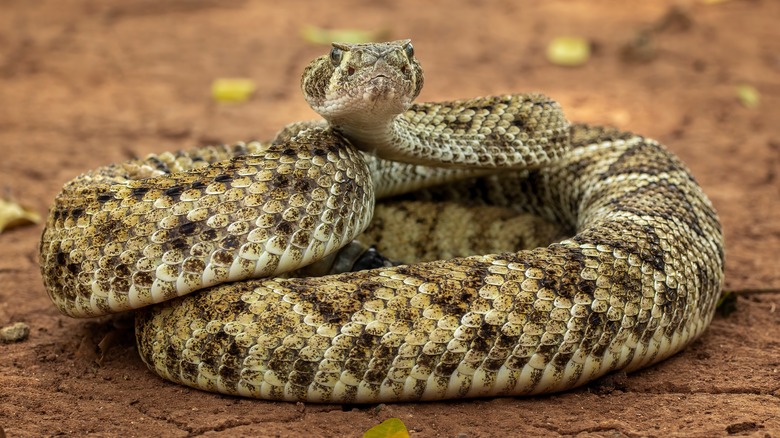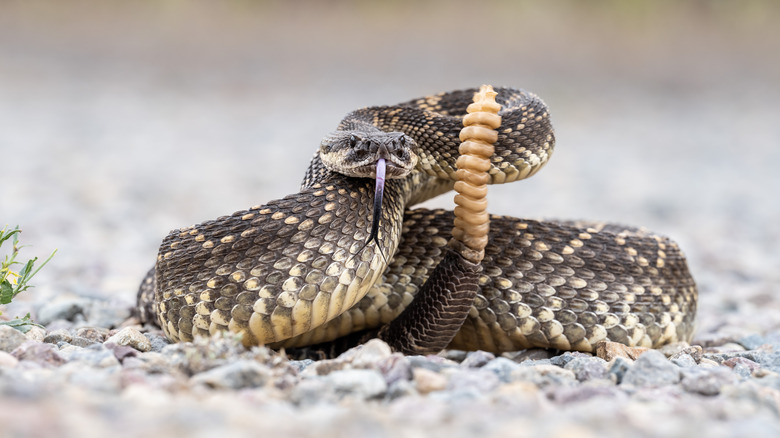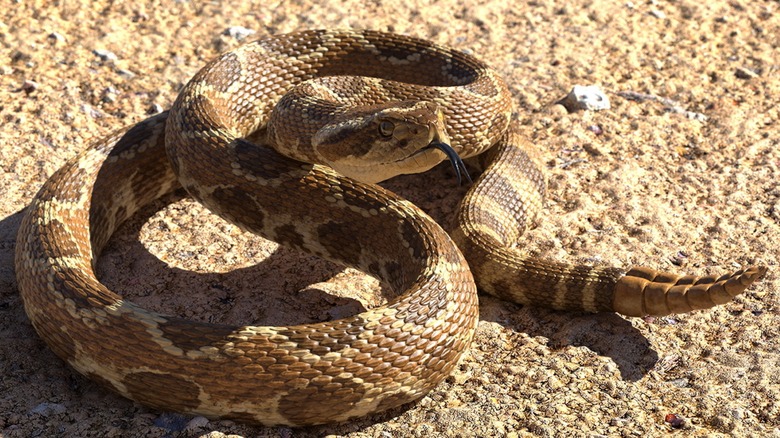If You Run Into A Rattlesnake While Hiking, This Is What You Need To Do
You're hiking along, enjoying a day out in nature. The birds are singing, the sun is shining, and then you hear it: the distinctive sound of a rattle. It's a noise that can strike fear into any hiker. Rattlesnakes are venomous, and that venom can kill you. It's not inevitable, however. While the U.S. Forest Service reports that approximately 8,000 rattlesnake bites happen yearly in the United States, there are only 10-15 deaths. That said, it's wise to be cautious when hiking.
There are over 25 species of rattlesnake in the country, and they serve an essential purpose: helping control the rodent population. These creatures are just trying to survive and protect themselves. You're in their territory, after all. They may be out enjoying the sunshine, trying to control their body temperature when you step on them or near where they're resting. They may be cooling off from the hot summer sun under a rock or inside a log when you stick your hand inside or grab it for firewood. They often try to warn you off by shaking their rattle, but that's not something you can count on. Here is what you need to know to keep yourself safe from rattlesnakes while hiking and what to do if you end up being bitten anyway.
How to prevent a rattlesnake bite
Rattlesnakes are largely dormant in the winter, but you may see them the rest of the year. These cold-blooded critters are usually out in the mornings and evenings during hot weather as they warm up or in the middle of the day when temperatures are cooler. If it's too warm, they may hide under rocks or houses or in tall grass. Though their brown and tan coloring makes it easy for them to hide, you can identify them by their triangular head, diamond-shaped patterning, and their famous rattle. If you've never heard one, it really does sound like a child's toy. If you were to run your finger over them, they'd be bumpy rather than smooth. (Do not do this under any circumstances.)
To avoid being bitten, stay on an open path where you can see the ground clearly. Wear proper shoes that cover your ankles and long pants. Do not hike in open-toed shoes or barefoot. If you're sitting down for a spell or setting up camp, check the area for snakes first. If you happen to come upon a downed tree or a large rock, step up to it instead of over without looking. Don't stick your hands and arms into anything you cannot see well. That includes the water to pick up a branch or twig because rattlesnakes can swim. Listen for a rattle, but don't rely on it, as they don't always use it. If you see one, step back slowly and give it room.
What to do if you're bitten by a rattlesnake
What do you do if you get a rattlesnake bite anyway? Don't panic, but do act fast. While about 33% of bites are "dry bites" with no venom, according to the US Forest Service, you should always assume there is venom present. That even goes for dead snakes, which can still envenomate you. First, call or radio 911 immediately. Then, remove anything that may constrict swelling, like tight socks or jewelry. Keep the bitten area below the heart and stay as calm as possible.
What you shouldn't do under any circumstances is suck out the venom, as you've likely seen in cartoons. (Most snakebite kits you may be carrying have a suction device instead. Venom in the mouth can be accidentally swallowed or end up in your bloodstream through cuts or abrasions.) Do not use alcohol or ice on the area. Do not use a tourniquet or cut into or around the bite. When you get medical help, you'll likely be treated with anti-venom.
If you happen to be hiking with a pet, keep them out of grassy areas and restrict the leash so you can keep control of them before it happens. If they're bitten, call the emergency vet right away, and again, keep the bite lower than the heart. Do your best to keep your pet calm. There is a rattlesnake vaccine available for dogs, though experts differ on whether or not to use it, so discuss this with your vet.


